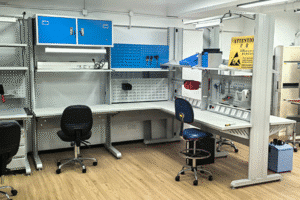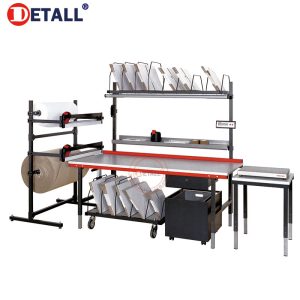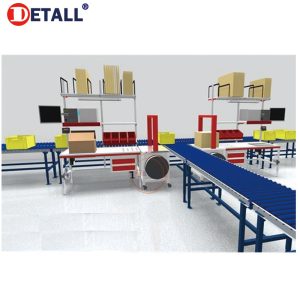The Ultimate Guide to Buying an ESD Table
Introduction: Why Choosing the Right ESD Table Matters
In today's high-tech era, electrostatic discharge (ESD) is an invisible threat that can cause severe damage to sensitive electronic components. A tiny static spark, almost imperceptible to humans, can destroy microchips, circuit boards, and other precision devices, leading to costly repairs, production delays, and product quality issues. ESD tables (also known as anti-static workbenches) are designed specifically to mitigate the risk of static electricity, protecting your electronics and investment.
Choosing the right ESD table is not just about buying a desk; it's a critical decision to ensure the safety of your products, protect your equipment investment, and maintain customer trust. This guide will provide a comprehensive overview of everything you need to know when purchasing an ESD table from a buyer's perspective. From the definition and working principle of ESD tables to assessing your specific needs and avoiding common mistakes, this article will equip you with rich knowledge to help you select the most suitable ESD table for your business.
What Businesses Need an ESD Table?
Before delving into ESD tables, it's crucial to understand which businesses need them. ESD tables are essential for companies that handle electrostatic sensitive devices (ESDS), including:
- Electronics Manufacturing and Assembly: Companies that produce or assemble everything from consumer electronics to industrial equipment, such as smartphones, computers, and control systems.
- Semiconductor Manufacturing: Factories producing integrated circuits and other semiconductor devices where ESD can cause product defects.
- Telecommunications: Businesses that manufacture and maintain communication equipment like routers, switches, and base station equipment.
- Aerospace and Defense: Industries requiring highly reliable electronic components for critical applications like satellites, radar, and navigation systems.
- Medical Device Manufacturing: Companies producing medical electronics such as pacemakers and diagnostic instruments where product reliability is paramount.
- Automotive Electronics: Manufacturers of automotive electronic components, including infotainment systems, sensors, and control units.
- R&D Laboratories: Labs designing and testing new electronic technologies need to protect prototypes and experimental equipment.
- Repair and Service Centers: Businesses that repair and maintain electronic devices must ensure components are not damaged during servicing.
In short, any environment involving the assembly, testing, or repair of electrostatic sensitive equipment can significantly reduce the risk of ESD damage by using ESD tables. For example, a small repair shop might need a compact ESD table, while a large semiconductor factory may require multiple customized large tables.
What is an ESD Table? A Quick Primer
An ESD table is a specially designed piece of furniture that prevents electrostatic discharge, providing a safe working environment for sensitive electronic components. It protects electronic devices from damage by controlling the accumulation and release of static electricity.
Definition and Basic Components
At the core of an ESD table is a work surface made from electrostatic dissipative materials, combined with a grounding system that safely directs static electricity to the ground. The work surface is typically made from laminate, vinyl, or other materials with specific electrical properties that allow static electricity to pass through at a controlled rate, preventing buildup.
Key components of an ESD table include:
- Anti-static Surface: The primary work area for handling electronic components, which must meet specific resistance standards to ensure effective static dissipation.
- Grounding Points: Connection points that link the work surface and accessories (like wrist straps) to a common ground, ensuring safe dissipation of static electricity.
- Optional Accessories: Including shelves, drawers, lighting, power strips, etc., to enhance functionality and convenience.
How ESD Tables Work
ESD tables prevent the buildup and sudden discharge of static electricity through the following mechanisms:
-
Electrostatic Dissipative Surface: The work surface typically has a resistance between 1.0 x 10^6 and 1.0 x 10^9 ohms (as per ANSI/ESD S4.1 and IEC 61340-5-1 standards). This resistance range is crucial because it allows static electricity to leak away slowly, preventing rapid discharges that could damage electronic components. If the surface is too conductive (low resistance), it may cause sudden discharges; if too insulating (high resistance), it cannot dissipate static electricity effectively.
-
Grounding System: The table is connected to a grounding terminal via a grounding cord, usually attached to the work surface. This connection ensures that any static charge on the table is safely directed to the ground. Additionally, operators often wear wrist straps connected to the table's grounding system to maintain the same electrical potential as the work surface.
-
Additional Features: Some ESD tables come with built-in ionizers that further reduce ESD risk by neutralizing static charges in the air. Others may include conductive or dissipative mats, storage bins, and tools, ensuring all items in the workspace are ESD-safe.
By combining these elements, ESD tables create a controlled environment that minimizes the risk of electrostatic discharge, protecting both electronic components and operators. These design features comply with international standards such as IEC 61340-5-1 and ANSI/ESD S20.20, which specify requirements for ESD control programs, including the properties of ESD protective work surfaces.
Table 1: ESD Work Surface Resistance Requirements
| Standard | Resistance Range (Ohms) |
|---|---|
| ANSI/ESD S4.1 | 1.0 x 10^6 to 1.0 x 10^9 |
| IEC 61340-5-1 | Typically 1.0 x 10^6 to 1.0 x 10^9 (aligned with ANSI/ESD S20.20) |
Note: IEC 61340-5-1 provides general requirements, with specific test methods and limits detailed in related standards like IEC 61340-2-3.
Key Factors to Consider When Buying an ESD Table
Now that you understand what an ESD table is and how it works, here are the key factors to consider when making a purchase.
1. Material and Surface Quality
The material of the work surface is critical to the performance of an ESD table. Common options include:
- Laminate: Features an electrostatic dissipative layer, durable, and cost-effective, suitable for most applications.
- Rubber ESD Worktop: features a two-layer rubber surface: a dissipative top layer and a conductive bottom layer. Its textured, non-glare finish adds friction to prevent slipping.
- ESD compact laminate: It features a compact structure, high durability, moisture and chemical resistance, and easy-to-clean, antibacterial properties..
Each material has its pros and cons. For example, the Laminate top is wear-resistant, heat-resistant, suitable for most operating environments, and can prevent burns during soldering. The Rubber ESD Worktop is the most common material, easily laid on tabletops, with the advantage of not requiring tabletop replacement and allowing direct installation later; however, its lifespan is shorter, and it is prone to aging and burns. The ESD Compact Laminate not only provides electrostatic protection and heat resistance but also resists acids and alkalis, making it suitable for more demanding environments. When choosing, ensure the surface resistance meets the standard (10^6 to 10^9 ohms) and check for quality certifications like RoHS or UL.
2. Size and Ergonomics
Select a table size that fits your workspace and workflow. Consider:
- Work Surface Area: Ensure there's enough space for all necessary tools and components.
- Adjustable Height: Ergonomically designed height-adjustable tables reduce operator fatigue and improve productivity.
- Legroom: There should be sufficient space under the table for comfortable seating.
For instance, a small repair station might need a compact table, while a large production line may require spacious tables to support multiple operators.
3. Grounding and ESD Protection Features
Ensure the table has proper grounding mechanisms:
- Grounding Cord: Should be included and easy to connect to a grounding terminal.
- Wrist Strap Connectors: Allow operators to ground themselves, maintaining the same potential as the work surface.
- Surface Resistance: Use a surface resistance meter to verify the resistance is within the standard range.
Some advanced tables may include grounding monitors or built-in ionizers to further enhance ESD protection.
4. Durability and Load Capacity
Consider the weight of the equipment and tools to be placed on the table:
- Load Rating: Tables typically support between 500 to 2000 pounds.
- Frame Material: Steel frames are sturdier than aluminum but heavier.
Choose a table that can withstand the weight of your equipment and ensure the frame can resist environmental factors like chemicals, heat, or humidity.
5. Customization and Accessories
Look for tables that can be customized to your needs:
- Multi-functionality and Adaptability: Modular Design, Customization Options,Workflow Adaptability.
- Shelves and Drawers: For storage and organization of tools and components.
- Lighting: Integrated lighting improves visibility in the workspace.
- Power Strips: Convenient access to power for equipment.
Modular designs allow for expanded functionality, such as adding storage or extending the work surface area.
6. Performance-to-Cost vs. Quality Considerations
ESD tables vary widely in price:
- Non-Professional Level ($100–$300): Typically consists of a basic table with an ESD mat placed on top. Suitable only for temporary or minimal static protection needs.
- Value Level ($300–$1,000): Offers reliable static protection for professional use, with assured quality and after-sales support. Best suited for bulk purchases to maximize value.
- High-End Level ($1,000–$2,500): Designed for specialized or custom requirements, featuring advanced functions. Suitable for individual unit purchases.
Balance cost with quality. Cheap tables may compromise on protection or durability, leading to higher long-term costs. Also, consider hidden costs like shipping, installation, and maintenance.
How to Evaluate Your Specific Needs
To choose the right ESD table, assess your specific requirements:
- Determine Application: Will the table be used for assembly, testing, or repair? Different uses require different features.
- Identify Space Constraints: Measure your workspace to ensure the table fits.
- Consider User Needs: How many people will use it? Is height adjustment necessary?
- List Required Features: Make a checklist of must-have and optional features.
- Set a Budget: Decide on an investment amount based on the importance of ESD protection.
Table 3: Needs Assessment Example
| Industry | Application | Recommended Features | Budget Range |
|---|---|---|---|
| Electronics Manufacturing | Large-scale assembly | Large modular tables, multiple grounding points | $1,000 - $2,000 |
| Repair Shop | Small device repair | Compact, height-adjustable | $500 - $1,000 |
| Laboratory | Testing and R&D | Chemical-resistant, cleanroom compatible | $1,500 - $3,000 |
Common Mistakes to Avoid When Buying an ESD Table
- Choosing Non-Certified Tables: Ensure the table meets ESD standards; otherwise, it may be ineffective.
- Neglecting Grounding Requirements: Improper grounding can lead to ESD protection failure.
- Ignoring Ergonomics: Uncomfortable workspaces can reduce efficiency.
- Focusing Solely on Price: Cheap products may compromise on quality and protection.
Step-by-Step Guide to Purchasing an ESD Table
- Assess Needs: Determine usage, space, and budget.
- Research Brands and Models: Compare features, prices, and reviews.
- Request Quotes: Contact suppliers for pricing and customization options.
- Verify Certifications: Ensure the table complies with relevant standards.
- Plan Installation: Consider shipping, assembly, and grounding setup.
- Test the Table: Verify ESD protection functionality after installation.
Maintenance Tips for Your ESD Table
To ensure the long-term effectiveness of your ESD table:
- Regular Cleaning: Use ESD-safe cleaners to maintain surface performance.
- Grounding Checks: Test the grounding system monthly with a resistance meter.
- Surface Care: Avoid using abrasive tools or non-ESD-safe items.
- Accessory Maintenance: Replace worn wrist straps or mats regularly.
FAQs About ESD Tables
-
What is the difference between an ESD table and a regular workbench?
- ESD tables have electrostatic dissipative surfaces and grounding features; regular workbenches do not.
-
How do I know if an ESD table is properly grounded?
- Use a surface resistance meter to test the grounding resistance, ensuring it is within 10^6 to 10^9 ohms.
-
Can ESD tables be used in cleanrooms?
- Yes, many ESD tables (such as those made of stainless steel) are designed for cleanroom use.
-
Are ESD tables worth the investment for small businesses?
- Absolutely, ESD tables prevent damage to expensive electronic components, saving costs in the long run.
-
How often should I test my ESD table's performance?
- It is recommended to test monthly or quarterly to ensure continuous protection.
Conclusion: Making an Informed Purchase Decision
Selecting the right ESD table is a critical decision for any business handling sensitive electronic components. By understanding the definition, working principle, and key purchasing considerations of ESD tables, you can choose a table that protects your investment and ensures product quality. Remember to assess your specific needs, choose brands that meet standards, and avoid common mistakes. With the right ESD table, you can create a safe and efficient work environment that minimizes the risk of electrostatic discharge.
Take Action Now: Ready to find your ideal ESD table? Browse our certified product range or contact our experts for free customized advice!



